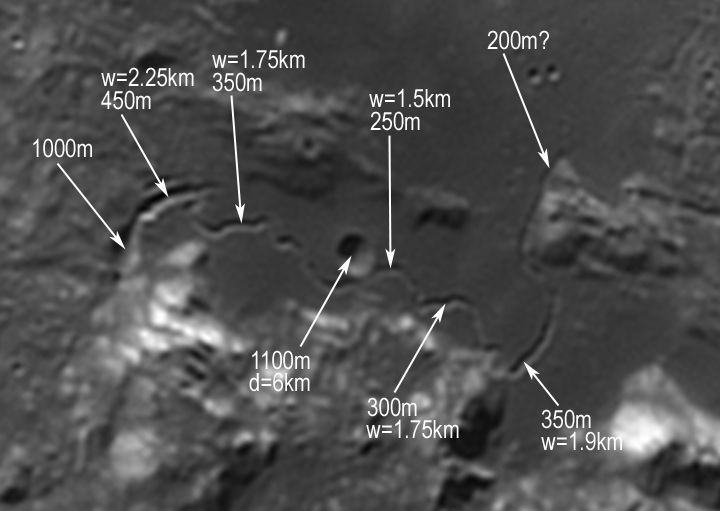
image and measurements by Bob Pilz
Here is a 4 times enlarged portion of an image of Rima Hadley. The lighting was such that shadows fell approximately in the middle of the rille, and I decided to try and use Jim Mosher and Henrik Bondo’s LTVT program to measure depths and widths. LTVT first requires that the image be calibrated by identifying the precise selenographic coordinates of two landmarks on the image. Using the 1994 UCLN list of benchmark locations I was able to obtain a very close calibration. I then used LTVTs shadow and distance tools to measure at locations on the rille that had fairly well defined edges. It’s difficult to do this accurately since the edges of shadows and the sides of the rille are not well defined. I could have made them more distinct by a greater application of sharpening to the image but I felt that might exaggerate edges and cause other types of errors - the rille is narrow even on this enlarged image and I didn’t want to perform excessive post-processing that might, for example, exaggerate the width. Even so, differences of + or - 50 meters in depth and .25 km in width are easy to come by with only slight movements of the mouse when establishing reference points. Measurements of depth could of course also be off if the shadow does not fall exactly in the middle of the rille. I’ve seen estimates of the rille’s depth as “greater than 300m” and 350m where Apollo 15 visited the rille. The Hadley LTO provides the most detailed measurements, and, as far as I can tell, my measurements roughly agree with it to a + or - 50 meter tolerance. I purposely did the measurements first and looked up the ‘answers’ afterwards so as not to bias myself. It’s interesting that there is considerable variance from end to end. Wider and deeper to the southwest and shallower at the northern end (Note: The small width and less distinct shadow at the northern end make that measurement especially suspect). What I hadn’t realized before is that the rille isn’t entirely contiguous. There are missing sections in the middle which are very curious. Orbital images show these areas as very shallow - almost like filled in areas bridging the rille. Also orbital images don’t seem to show anything either side of the rille that would account for this, for example, like ejecta from a distant impact. If the rille is a lava channel it’s not clear to me how these ‘filled in’ areas came to be. I also measured the crater Hadley C. VMA lists it as 6km x 6km and 500 m deep. My size measurement is identical but my measured depth is more than twice as great and agrees roughly with the 1177 m shown on the Hadley LTO.
Bob Pilz
Comment by Chuck Wood: (1) This is a nice example of how LTVT’s ability to easily make measures of widths and depths can enrich understanding of the Moon. (2) Hadley Rille is a lava tube/channel. Places where the tube roof hasn’t collapsed would be continuous across the rille. I am not sure this occurs at Hadley, but it's common in other sinuous rilles. (3) Finally, the crater Hadley C has a depth of 1.12 km according to measures we made in the early 1970s and Arthur published in 1974.
Technical Details:
10 Dec, 2006, ~08:25 UT. 200mm f/6 Newtonian reflector, Televue 3x Barlow , DMK 21BF04 B/W camera, ‘Blue’ IR-block filter, .20 arcsec/pixel; 30 fps, 1/50 sec, 600/6000 frames stacked. Processed in Registax, ImagesPlus, PS CS.
Related Links:
Rükl chart 22
Bob’s website
Yesterday's LPOD: Young's Old Catalogue
Tomorrow's LPOD: A Christmas Present
COMMENTS?
Register, Log in, and join in the comments.



